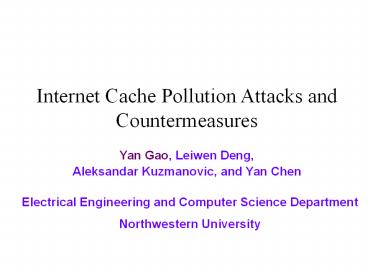Internet Cache Pollution Attacks and Countermeasures - PowerPoint PPT Presentation
Title:
Internet Cache Pollution Attacks and Countermeasures
Description:
... caches themselves become victims Little attention given to such attacks Existing pollution attacks mostly on content pollutions on P2P systems Contributions ... – PowerPoint PPT presentation
Number of Views:311
Avg rating:3.0/5.0
Title: Internet Cache Pollution Attacks and Countermeasures
1
Internet Cache Pollution Attacks and
Countermeasures
- Yan Gao, Leiwen Deng,
- Aleksandar Kuzmanovic, and Yan Chen
Electrical Engineering and Computer Science
Department Northwestern University
2
Outline
- Motivation
- Pollution Attacks
- Evaluation of Pollution Effects
- Counter-Pollution Techniques Evaluation
- Conclusion
3
Motivation
- Caching has been widely applied in the Internet
- Decrease the amount of requests in server side
- Reduce the amount of traffic in the network
- Improve the client-perceived latency
- Open proxy caches are used for various
abuse-related activities - Proxy caches themselves become victims
- Little attention given to such attacks
- Existing pollution attacks mostly on content
pollutions on P2P systems
4
Contributions
- Propose a class of pollution attacks targeted
against Internet proxy caches - Locality-disruption (LD) attacks
- False-locality (FL) attacks
- Analyze the resilience of the current cache
replacement algorithms to pollution attacks - Propose two cache pollution detection mechanisms
- Detect LD, FL attacks, and their combination
- Leverage data streaming computation techniques
5
Outline
- Motivation
- Pollution Attacks
- Evaluation of Pollution Effects
- Counter-Pollution Techniques Evaluation
- Conclusion
6
Pollution Attack Scenarios (I)
Attacking a web cache
Attacking an ISP cache
7
Pollution Attack Scenarios (II)
?
?
?
?
?
?
?
?
Pollution attack against a local DNS server
8
Pollution Attack Locality Disruption
Before attack
After attack
New unpopular files
Popular files
....
....
....
....
Cache
Cache
- Goal degrade cache efficiency by ruining its
file locality - Activities continuously generate requests for
new unpopular files
9
Pollution Attack False Locality
Before attack
After attack
Bogus popular files
Popular files
....
....
....
....
Cache
Cache
- Goal degrade the hit ratio by creating false
file locality - Activities repeatedly request the same set of
unpopular files
10
Outline
- Motivation
- Pollution Attacks
- Evaluation of Pollution Effects
- Counter-Pollution Techniques Evaluation
- Conclusion
11
Evaluation Methodology
- Discrete-event simulator
- Multiple DoS behaviors
- Multiple workload characterizing behaviors
- Effects of access and local network capacities
- Workloads
- P2P K. Gummadi et al. ACM SOSP 03
- Web F. Smith et al. SIGMETRICS 01
- NAT effects
12
Cache Replacement Algorithms
- Least Recently Used (LRU) algorithm
- Evict the least recently accessed document first
- Least Frequently Used (LFU) algorithm
- Evict the least frequently accessed document
first - Greedy Dual-Sized Frequency (GDSF) algorithm
- Consider the frequency of the documents
- Allow smaller document to be cached first
- Use dynamic aging policy
13
Baseline Experiments
- Locality-disruption attacks
Total hit ratio
Including attackers requests and regular users
requests
Stealthy! (4)
Small percent of malicious requests can
significantly degrade the overall hit ratio
14
Baseline Experiments
- False-locality attacks
Total hit ratio is not a good indicator for
attacks
15
Byte damage ratio
BHR(n)byte hit ratio of regular clients without
attacks BHR(a)byte hit ratio of regular clients
with attacks
16
Replacement Algorithms
- Locality-disruption attacks
LRU and LFU are more resilient to attacks, but
still can not protect cache from pollution
17
Outline
- Motivation
- Pollution Attacks
- Evaluation of Pollution Effects
- Counter-Pollution Techniques Evaluation
- Conclusion
18
Detecting Locality Disruption Attacks
- Observations
- Low total hit ratio
- Short average life-time of all cached files
- Design
- Detection compute the average durations for all
files in the cache - Mitigation recognize the attackers
19
Detecting False Locality Attacks
- Observations
- Clients who request a similar set of files
residing in the cache - The repeated requests from the same IP to cached
files - Design
- Large number of repeated requests
- Large percent of repeated requests
- Scalability
- Attacker-based detection Bloom filter
- Object-based detection Probabilistic Counting
with Stochastic Averaging (PCSA)
20
Evaluation of Pollution Detection
- Results for false-locality attacks, more in paper
For attackers file detection True positive
ratio
21
Implementation
- Realize the counter-pollution mechanisms
- Code and more details
- http//networks.cs.northwestern.edu/AE/
22
Conclusions
- Propose and evaluate two classes of attacks
locality-disruption and false-locality attacks - Show that pollution attacks are stealthy, but
powerful, and different replacement algorithms
have different resiliency - Propose and evaluate a set of scalable and
effective counter-pollution mechanisms































